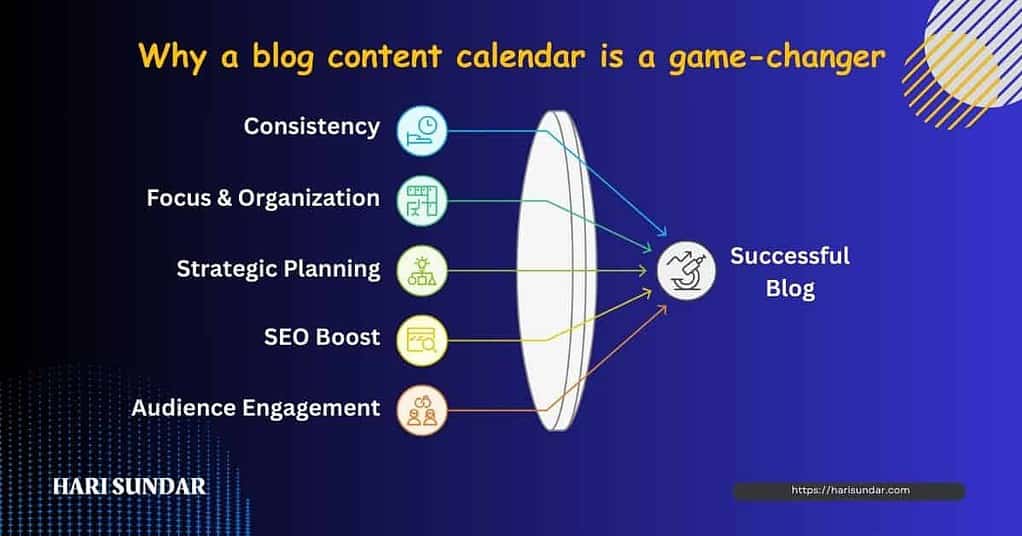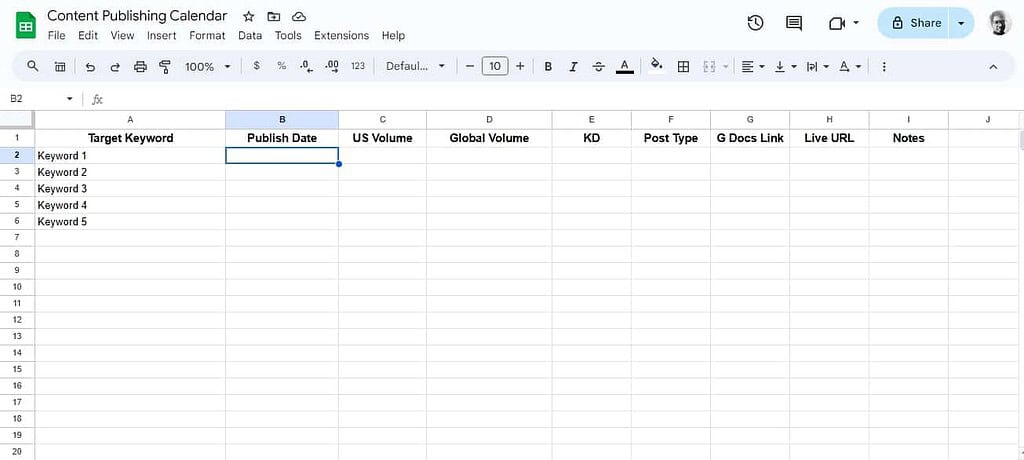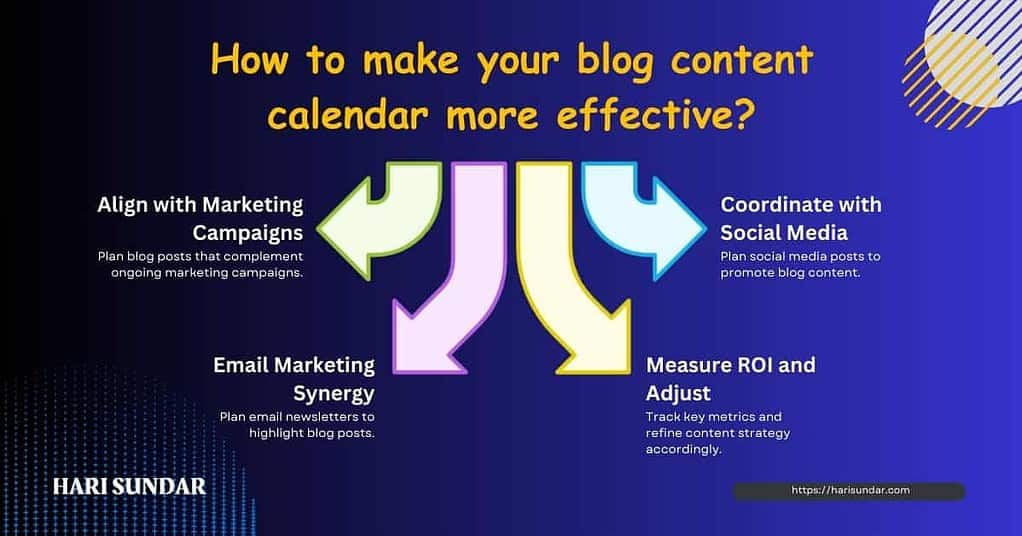Blog Smarter: Craft Your Ideal Blog Content Calendar In 2024

Before a content calendar, I would take one full month to publish 2 blog posts, then crickets for weeks. My traffic bounces around like a ping-pong ball. Sound familiar?
But everything changed when I discovered the magic of a blog content calendar. After having it, I published 4 posts in just a week!
I was amazed by the power of the blog content calendar. It’s not a fancy schedule – it’s your roadmap for creating, organizing, and publishing content that hits the mark every time.
Forget those cookie-cutter approaches to starting a blog. Stick around, and I’ll show you how this simple tool can transform your blogging game.
Whether you’re figuring out how to learn to blog or you’re looking to create a blog calendar, I’ve got your back.
Here’s what you’ll learn: From basics to advanced tactics.
🚀 Turn your random posting into a content machine
🧠 Craft a calendar that works for you, not against you
🛠️ Build your calendar from scratch (no fancy tools required)
💡 Steal my tips for keeping your calendar fresh and effective
🔗 Make your blog a key player in your marketing game
Ready to see how you can blog smarter? Let’s get to it!
Understanding the Importance of a Blog Content Calendar
A blog content calendar helps you write blog posts faster and helps you stay consistent. Let me break it down for you because your readers love knowing when to expect new stuff.
It enables you to stay organized, plan strategically, and even gives your SEO a nice boost. It’s a plan that maps out what you’re going to publish and when.
Simple, right?
But trust me, it’s powerful stuff. Once I started using it, I went from struggling to post twice a month to pumping out four to five solid articles every week. That’s the kind of boost we’re talking about.
Here’s why a content calendar is a game-changer:
- Consistency wins: Regular posts keep your audience coming back for more.
- Better focus & organization: With a content calendar, you’ll focus on one thing at a time.
- Strategic planning: Align your content with your overall blog goals and marketing campaigns.
- SEO boost: Plan your keywords and topics for better search engine performance.
- Audience engagement: Keep your readers hooked with a well-planned content mix.

Without a content calendar, you’re flying blind. It’s like trying to build a house without blueprints.
Sure, you might end up with four walls and a roof, but it probably won’t be the dream home you envisioned.
Now, let’s talk about the key components that make content creation easy.
Key Components of an Effective Blog Content Calendar
Now that we know why a content calendar is so important, let’s break down what actually goes into one.
In this section, I’ll show you the essential pieces that make up a killer content calendar. From picking your topics to setting deadlines, we’ll cover it all.
First up, have a set of keywords for your blog, because keyword research is crucial for blogging. Note down the target keywords, difficulty levels, and search volume in your calendar.

Then comes topic categories. These are like the chapters of your blog’s story. For example, on my blog, I have categories like SEO, blogging, and guides.
Having these categories helps me make sure I’m covering all my bases and not just harping on the same old topics.
Next, we’ve got publishing dates and frequencies. This is where the rubber meets the road.
When I started, I aimed for two posts a week. It was challenging at first, but having those dates locked in kept me accountable.
Author assignments and deadlines are crucial if you’re working with a team. Even if it’s just you, setting personal deadlines can be a game-changer. Trust me, nothing motivates me like a looming deadline!
Content types are another key piece. Mix it up! Include how-to guides, listicles, reviews, comparison posts, etc.

Because variety is the spice of life, and it keeps your audience engaged.
Lastly, don’t forget about distribution channels. Where are you sharing your content? Your blog, sure, but what about social media, email newsletters, or guest posts on other sites?
Even you can create separate calendars for social media posts and guest posting.
You can also create a section for notes. keep in mind, that your content calendar is a living document. It should evolve as your blog grows and changes.
The goal is to create a system that works for you, not to follow some rigid set of rules.
So, now that we know what goes into a content calendar, how do we actually put one together? Now, I’ll walk you through creating your very own blog content calendar, step by step.
Create Your Blog Content Calendar
Alright, let’s roll up our sleeves and get down to business. Creating a content calendar is not rocket science.
Assess Your Blog’s Goals and Target Audience: First things first, what’s your blog all about? Are you aiming to educate, entertain, or maybe a bit of both?
For me, I wanted to help new bloggers get into digital marketing. Knowing your goals helps shape your content.
And don’t forget about your audience – who they are, and what they want to learn.
Brainstorm Content Ideas and Themes: When I was starting, I came up with a bunch of blog ideas for beginners. Consider your audience’s questions and how you can answer them.
Choose the Right Tools: You don’t need anything fancy to start. I began with a simple Google Sheet, but there are plenty of project management tools out there if you want to get fancy.
Pick something you’re comfortable with – the goal is to make your life easier, not more complicated.
Set Up Your Calendar Structure: This is your content roadmap. I like to plan a month, but you do what works for you.
Include columns for publishing date, title, category, target keyword, difficulty, status, and permalinks. It helps keep everything organized and on track.
Remember, your content calendar isn’t set in stone. The key is to start somewhere and refine as you go.
Now that we’ve got our calendar set up, what tools can make this process even smoother? Let’s explore some options that could take your content planning to the next level.
Tools and Templates for Blog Content Calendars
Now that we’ve got the basics down, let’s talk tools. I was overwhelmed by all the fancy options out there. But the truth is you don’t need anything complicated to get started.
I use Google Sheets, and honestly, it’s more than enough when you’re starting.
It’s free and easy to use, and you can access it from anywhere. Plus, you can easily share it with team members if you’re working with others.
But if you’re looking for something more robust, there are plenty of options:
- Trello: Great for visual planners. You can create boards for different content stages.
- Asana: Perfect if you’re working with a team. It’s got great collaboration features.
- CoSchedule: This one’s built specifically for content marketing. It’s got some neat features, but it comes with a price tag.
There are also tons of free and premium templates available online. You can find everything from simple spreadsheets to complex project management systems.
The key is to find one that works for you and customize it to fit your needs.
The best tool is the one you’ll use. Don’t get caught up in fancy features you’ll never touch. Start simple, and you can always upgrade later if you need to.
Tips for Maintaining and Optimizing Your Content Calendar

Alright, you’ve got your calendar set up. Now, how do you keep it running smoothly? A content calendar needs regular TLC to shine. It’s not a one-time task, set it and forget it.
Here are some tips I’ve picked up along the way:
- Regular Content Audits: Every few months, take a step back and look at the big picture. Which posts performed well? Which ones flopped? Use this info to guide your future content. I do this quarterly, and it’s amazing how much it helps refine my strategy.
- Balance Evergreen and Timely Content: Evergreen content is great for SEO. But relevant timely pieces can drive short-term traffic spikes. I aim for an 80/20 split but find what works for you.
- Stay Flexible: If a trending topic pops up in your niche, don’t be afraid to shuffle things around. Adjust to your needs but stay consistent.
- Listen to Your Audience: Pay attention to comments, social media, and emails. What questions are your readers asking? Use this feedback to fuel your content ideas.
- Collaborate Effectively: If you’re working with a team, clear communication is key. Use your calendar to assign tasks, set deadlines, and track progress. I use color coding to show different stages of content production.
- Repurpose Content: Don’t reinvent the wheel. Look for ways to repurpose your existing content. Can that popular blog post become a video or infographic?
- Plan for Seasonality: Consider holidays, industry events, or seasonal trends in your niche. I always plan some holiday-themed content in advance.
Keep in mind, that optimizing your content calendar is an ongoing process. It’s okay to experiment and make adjustments as you go.
The goal is to create a system that works for you and helps you consistently produce great content.
So, you’ve got your calendar set up and running smoothly. But how does all this fit into your bigger marketing picture?
Let’s explore how to integrate your blog content calendar with your marketing strategy.
Integrating Your Blog Content Calendar with Marketing Strategy

Your blog is the key player in your marketing game. I treated my first blog as a hobby, and after so many mistakes, I learned to turn my blog into a personal brand.
Once I aligned it with my marketing strategy, everything clicked. I started to treat my blog as a business model.
Let’s talk about making your blog content calendar work hand-in-hand with your broader marketing efforts:
- Aligning with Marketing Campaigns: Let’s say, you’re going to launch a digital product for your business. Then plan blog posts that discuss related topics or showcase the product’s benefits.
- Coordinating with Social Media: Use your content calendar to plan social media posts that promote your blog content. I like to create a mix of teaser posts, quotes, and behind-the-scenes content to drum up interest before a blog post goes live.
- Email Marketing Synergy: Your blog and email list should be best friends. Use your content calendar to plan email newsletters that highlight your latest posts. Sending a weekly roundup of the top blog content will increase your email open rates.
- Measuring ROI: Track key metrics like pageviews, time on page, and conversion rates for each blog post. Use this data to refine your content strategy. I review these metrics monthly and adjust my content calendar accordingly.
- Adjusting Strategies: Be flexible. If certain types of content consistently perform well, consider increasing their frequency. On the flip side, don’t be afraid to cut underperforming content types.
So, you can use your blog content calendar as a strategic tool to amplify your marketing efforts.
By aligning your blog with your broader strategy, you’ll create a cohesive brand message that resonates with your audience.
So, are you ready to take your blog from a standalone project to a key player in your marketing strategy?
Let me know in the comments below.
Let’s recap what we’ve learned and make sure you start implementing these ideas right away.
Conclusion
Alright, let’s wrap this up. A content calendar isn’t just some fancy tool for big-shot bloggers. It’s your ticket to turning your blog from a hobby into a powerhouse.
Trust me, the benefits of blogging with a solid plan are game-changing.
The best content calendar is the one that doesn’t gather digital dust. Start small, be consistent, and tweak as you go. Your calendar should be your sidekick, not your taskmaster.
So, here’s your challenge: Open up that spreadsheet or grab that notebook. What’s one topic you’ve been itching to write about? Jot it down.
Congrats, you’ve just taken the first step towards content calendar mastery.
What’s stopping you from planning your next month of content right now? Tell me in the comments and I will try to solve it.
Your future readers are waiting. Are you ready to give them what they’re looking for?
FAQs On Blog Content Calendar:
Is a blog content calendar really necessary for a small blog?
Absolutely. Without a blog content calendar, it felt hard for me to publish even two posts a month. Once I implemented it, I pumped out 4 quality posts weekly. It’s not about size; it’s about consistency and growth. A calendar helps you plan, stay focused, and build momentum.
How often should I update my content calendar?
I review mine monthly. But be flexible. I adjust based on performance, trends, and audience feedback. Regular updates keep your content fresh and relevant. Aim for a quarterly deep dive to realign with your blogging goals.
Can I use a simple spreadsheet for my content calendar?
Definitely. I use Google Sheets, and it works great. No need for fancy tools when you’re starting. A basic spreadsheet with columns for dates, topics, keywords, and status is enough. You can always upgrade later if you need more features.
How far in advance should I plan my blog content?
I plan a month ahead, but it varies. Some bloggers do quarterly, others weekly. Start with 2-4 weeks and see what feels right. The key is having enough runway to create quality content without feeling overwhelmed.
What if I can’t stick to my content calendar?
Don’t sweat it. Life happens. I’ve missed deadlines too. The calendar is a guide, not a tyrant. If you fall behind, just adjust. The goal is progress, not perfection. Keep moving forward, even if it’s slower than planned.
How do I come up with enough ideas to fill my content calendar?
Listen to your audience. Check comments, emails, and social media. I get tons of ideas from reader questions. Also, stay on top of industry trends. Do keyword research, and mix evergreen topics with timely content. And don’t forget to repurpose your existing popular posts.
Should my content calendar include social media posts too?
It can, but start simple. I focus on blog posts first, then plan social media around them. As you get comfortable, you can expand to include social posts, emails, and other content types. The goal is to create a cohesive content strategy across platforms.





